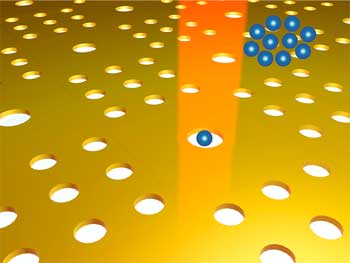
Tuesday, June 26, 2018
Fluorescence imaging technique goes from micro to macro, moves closer to clinic
FLIM used to analyze whole mouse tumor with cellular resolution.
Nanoscale membrane both isolates and couples living and non-living catalysts
Innovation paves the way for scaling up biohybrid systems to synthesize fuels, chemicals.

Shining a light on gene regulation
This promising method involves coating nanoparticles with gene-regulatory agents and then exposing them to a dose of laser light to unleash that material.

New metasurface tech improves ability to reflect sound back to its source
Researchers have developed a device that reflects sound in the direction it came from, rather than deflecting it at an angle. The 'retroreflector' can reflect sound across an operating range of 70 degrees in either direction -- more than doubling the effective range of previous technologies.

Electron paramagnetic resonance in modern carbon-based nanomaterials
Electron Paramagnetic Resonance in Modern Carbon-Based Nanomaterials, is a new book which attempts to fill the abovementioned void by compiling key contributions for researchers interested in the electron paramagnetic resonance study of the carbon-containing thin films, nanomaterials, ceramics, porous materials, etc.

Nanocellulose-coated PET film provides low-cost, sustainable option for food packaging
Researchers have developed a large-scale manufacturing process that may change the way some grocery store foods are packaged.

Research on cancer-frying nanoparticles heats up
Scientists have improved the performance of magnetic nanoparticles designed to roast and destroy tumors.

Twisted meta-molecules as they really are
Physicists have devised a clever way to truly test the chirality of a material, eliminating the risk of false positives from other techniques.

Nanotweezer lab-on-a-chip holds promise of early cancer diagnosis
Researchers used plasmonics to develop a new kind of nanotweezers that can rapidly trap and detect molecules, viruses and DNA - a device transformative for medicine that also has color printing applications.

Asymmetric plasmonic antennas deliver femtosecond pulses for fast optoelectronics
Researchers have succeeded for the first time in generating ultrashort electric pulses on a chip using metal antennas only a few nanometers in size, then running the signals a few millimeters above the surface and reading them in again a controlled manner.

Efficient, eco-friendly production of fine chemicals with single-atom catalyst
Chemical engineers have developed a new catalyst for forming a bond between two carbon atoms in a cost-effective and eco-friendly way.

Engineer creates new design for ultra-thin capacitive sensors
The thin and flexible sensor is ideal for sensing sounds because it can move with the airflow made by even the softest noises and addresses issues with accelerometers, microphones and many other similar sensors.

Team's e-whiskers may be a touchstone for future of electronic skin
Researchers used shape-memory polymers to create artificial, electronic versions called e-whiskers, which mimic the properties of the real thing.

Nanomaterials could mean more algae outbreaks for wetlands, waterways
High tech metal particles may inadvertently take a toll on aquatic life.

Subscribe to:
Posts (Atom)
